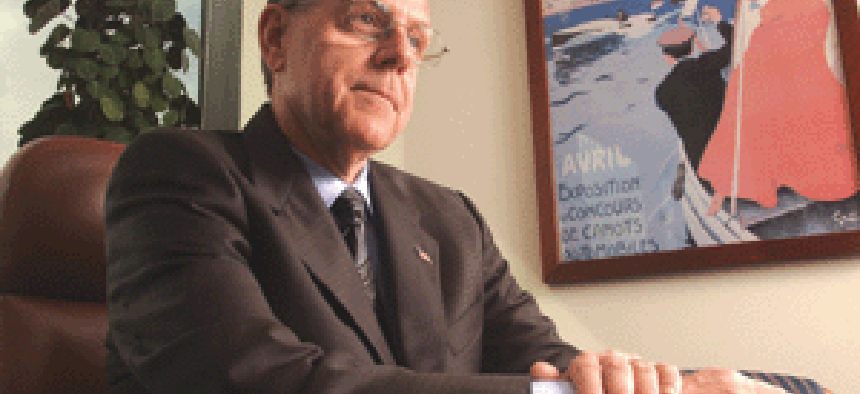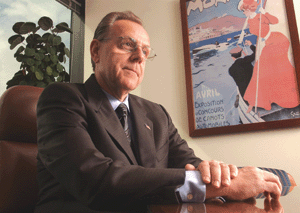Dahlberg looks to pump up SAIC

Shortly after Ken Dahlberg was named chief executive officer of Science Applications International Corp. in November, he received calls from the Secretary of the Navy, the National Security Agency, the National Geospatial-Intelligence Agency and other federal agencies with which the company has done business.
Shortly after Ken Dahlberg was named chief executive officer of Science Applications International Corp. in November, he received calls from the Secretary of the Navy, the National Security Agency, the National Geospatial-Intelligence Agency and other federal agencies with which the company has done business."These are people whom I know, and we talked about areas that need to be improved" at SAIC, Dahlberg said in an interview with Washington Technology. One of those areas was SAIC's famously decentralized organization, which has spurred employee creativity but also has confused and upset government customers. Dahlberg did not elaborate on his conversations with the agencies, but a long-time industry observer recalled an episode in the mid-1990s when a defense agency received three different bids from three different teams at SAIC on one contract. The contracting officers "were really [angry] at SAIC, because they had to evaluate all three proposals," he said.It might have been the input Dahlberg got from SAIC's high-ranking customers, or it could have been the days upon days of briefings he got from different -- and overlapping -- units within the company. After just two months as head of the government integrator, Dahlberg announced Jan. 8 a sweeping reorganization of the 42,000-employee company that will go into effect at the beginning of February.Dahlberg has organized SAIC, which had consisted of five loosely grouped clusters and Telcordia Technologies, the company's telecommunications unit, into three main business segments: federal, commercial and Telcordia. Duane Andrews was named corporate executive vice president, president and chief operating officer of the federal business segment. Randy Walker, corporate executive vice president, will head the commercial unit. Matt Desch will be CEO of Telcordia.Within federal, there will be five groups: research and intelligence; system and network solutions; test, training, transformation and logistics; enterprise and infrastructure solutions; and naval engineering and technical services. They will encompass 25 business units, to be identified after the reorganization."I think it makes SAIC a much better company," said Tom Meagher, vice president of equity research at BB&T Capital Markets, Richmond, Va. Although Meagher doesn't rate SAIC because it is privately held, he tracks it because it's an important competitor of the public companies he evaluates."They've always had a very decentralized culture there. The employees benefited, but there were times it would be detrimental to their clients," Meagher said. "Now, there will be a much more disciplined organization, and it will improve their standing with their clients."The only drawback to the job so far is the traffic, Dahlberg said. "Wait until you come out to San Diego. It's a nightmare," he said. "Every time I have a meeting, I have to allow extra time."Dahlberg said the most difficult aspect of his job at first was that his management team was spread out over a larger geographic area than he was used to -- thus, the traffic headaches and the move to consolidate his team at the company's headquarters campus in San Diego.WORKING WITH A MASTERWith the reorganization, Dahlberg begins reshaping a company and culture dominated for more than 30 years by Robert Beyster, SAIC's founder. The 79-year-old Beyster remains as chairman of the board, though he has indicated he may step down before his term expires in July.Under Beyster's guidance, SAIC has become one of the top contractors in the government IT market. It ranked No. 3 on Washington Technology's 2003 Top 100 list of prime federal contractors and had 2003 revenue of $5.9 billion."I listen a lot to Dr. Beyster. He's a terrific resource [and] he really believes, as I do, in solving national security issues," Dahlberg said. "He's transitioned the CEO responsibility to me, and gee, it's lovely to get to a company that's not in dire shape."Although change usually evokes uncertainty in employees, Dahlberg said the employee-owners of SAIC have been positive about the reorganization. "A lot of people have got skin in the game. We've got a young work force [and] a lot of people see real career opportunities," he said.The reorganization is not the only big change Dahlberg has put in place. SAIC just finished its fiscal 2005 planning."I think for the first time here we're looking out in a multiyear process," Dahlberg said. "Three years is not too far out to do reasonable forecasting."Setting the corporate course for the next three years is essential to Dahlberg's goal of doubling the company's size over the next five years, from almost $6 billion in revenue to between $12 billion and $15 billion. Much of that growth will be in the federal sector, which already accounts for more than two-thirds of SAIC's business."Where Secretary [of Defense Donald] Rumsfeld sees his priorities, we see a good growth percentage," Dahlberg said. Intelligence, homeland security and command and control systems are areas where SAIC is well positioned, he said.On the commercial side, "the lens is not opaque, but it's not transparent yet," Dahlberg said. "I've been making the rounds with our [regional Bell operating company] customers, British Petroleum, Pfizer, Bristol Myers Squibb. ... At least at the CIO level, I'm seeing more of a willingness to engage companies like ourselves to improve efficiencies, reduce time to market."With $3.7 billion in reserves, the privately held company will be "using the balance sheet for the proper deployment of capital," he said, looking for acquisitions "where we need to round out our competency."Richard Knop, managing partner of the Windsor Group, a Reston, Va. investment banking firm, predicts that SAIC will be very active on that front."I would anticipate a lot of activity," he said. "I know they're going to both be on the acquisition trail, as well as the divestiture trail. [Dahlberg's] definitely going to put his imprimatur on SAIC."Dahlberg also said he is happy to be back at a science and technology company. "I am a techie. I have to remember now that I'm not a COO, but a CEO," Dahlberg said. "I'm trying to get technology tied to our business strategy, tied to growth. I look forward to doing that."The company holds several high-profile contracts, including one to provide security for the 2004 Summer Olympics in Athens, Greece. U.S. and European intelligence and counterterrorism agencies have expressed concern that the Greek government waited too long to award the contract and that security measures won't be ready in time. "We're putting all the company resources in place to be sure we deliver on what we promised," he said. *Staff Writer Patience Wait can be reached at pwait@postnewsweektech.com.
 After moving quickly to centralize management, new chief seeks to double revenue in five years
After moving quickly to centralize management, new chief seeks to double revenue in five years

"I listen a lot to Dr. Beyster. He's transitioned the CEO responsibility to me, and gee, it's lovely to get to a company that's not in dire shape." ? Ken Dahlberg, CEO and president, SAIC
Sandy Huffaker
NEXT STORY: Test information management